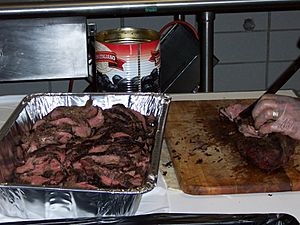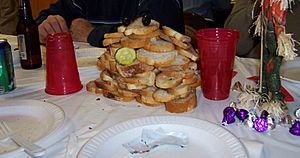Beefsteak (banquet) facts for kids
A beefsteak banquet is a special kind of party where lots of sliced beef is served. Guests eat the beef with their fingers, and it's usually "all-you-can-eat." This unique way of dining started in New York City in the 1800s. It was a popular way for working-class people to celebrate.
Over time, beefsteak banquets became less common. But they stayed popular in parts of New Jersey, especially in Bergen and Passaic counties. Now, this fun dining style is even making a comeback in New York City, where it first began!
Contents
How Beefsteaks Started
Beefsteak banquets first appeared in New York City in the mid-1800s. They were often used as celebrations or to raise money. For example, groups might throw a beefsteak to honor a politician or a friend who got a promotion. Even famous people like Sophie Tucker had beefsteaks held for them in the 1930s.
Early beefsteaks were usually just for men. The atmosphere was very relaxed and informal. People often sat on crates and ate with their fingers from simple tables. The main focus was on the food and drinks. Entertainment was often just people telling stories and singing together. Sometimes, a brass band would play music.
Early Beefsteak Styles
Even though the main idea was to eat lots of beef and drink, there were different ways beefsteaks were served. In the 1930s, there were two main styles in New York City. These were called "East Side" and "West Side" styles. Each group thought their way was the original and best.
"East Side" beefsteaks were mostly for working-class people and immigrants. These parties focused heavily on meat. They served sliced beef, beef kidneys, and ground beef. One East Side beefsteak was said to have served over 3,000 pounds of steak!
"West Side" beefsteaks were often held in more formal places. They had a wider variety of foods. Besides beef, they might serve crab meat, lamb chops, and baked potatoes. Guests at West Side beefsteaks could use forks for some foods. But they still had to eat the main beef course with their fingers.
Dining with Your Fingers
Both types of beefsteaks agreed on one thing: eating with your fingers was key! Guests were not afraid to get messy. The main course was thinly sliced beef loin. It was dipped in a buttery sauce and served on rounds of bread. East Side beefsteaks used day-old bread, while West Side ones used fresh toast.
Napkins were not usually given out. Instead, diners wore aprons to wipe their greasy hands. Waiters kept bringing out trays of food until everyone was completely full. Before Prohibition (when alcohol was banned), beer flowed freely during these banquets.
How Beefsteaks Changed
Big changes happened to beefsteaks in the early 1900s. In 1919 and 1920, new laws were passed in the U.S. These laws were the 18th Amendment (which led to Prohibition) and the 19th Amendment (which gave women the right to vote).
After women gained the right to vote, politicians started inviting them to beefsteak banquets. With women attending, the parties became more polite. Cocktails replaced large pitchers of beer. Foods like fruit cups and salads were added to the menus. Orchestras were hired instead of brass bands. And forks and knives, once forbidden, started appearing on tables.
By the 1930s, beefsteaks were not as messy or "manly" as they used to be. They became more like formal meals. People still ate a lot of beef and bread, but it was done with more manners.
In 1938, a butcher named "Hap" Nightingale in Clifton, New Jersey started catering parties. He used the old beefsteak style. He offered an all-you-can-eat menu of French fries and sliced beef tenderloin on bread. His business did very well. His family has continued the tradition, sticking to the original formula.
Beefsteaks Today
Modern beefsteak banquets are quite similar to the ones from the early 1900s. The menu is usually beef, fried potatoes, and a tossed salad. Sometimes, butter is replaced by margarine. A pasta course might also be added. But guests still expect to eat lots of beef tenderloin.
At modern beefsteaks, people often follow a fun tradition. They pile up their bread slices in front of their plate instead of eating them. This saves room in their stomach for more beef! It also acts as a way to keep track of how much beef they've eaten.
Where Beefsteaks Are Popular Now
Beefsteak banquets have mostly disappeared from New York City, where they began. But they are still very popular in Bergen and Passaic counties in New Jersey. They are a big part of the local culture there. Caterers in the region put on about 1,000 beefsteaks in 2007 alone!
There is also a popular beefsteak held twice a year in Brooklyn. Some schools in New York City, like Regis High School and Xavier High School, host annual beefsteaks for their former students.
Today, beefsteaks are not usually for political fundraising in New Jersey. Instead, they often raise money for fire departments, police groups, and other charities. Some restaurants in the New York area even host gourmet beefsteaks for food lovers.
Since 2009, two college graduates, Andrew Dermont and Derek Silverman, have held a "beefsteak for beefsteak's sake" in Brooklyn. They want to bring back the tradition to New York City. In Los Angeles, Chef Neal Fraser and others have hosted a beefsteak since 2011 to raise money for the LA Food Bank. Also, since 2015, Chef Tom Colicchio's Riverpark Restaurant in Manhattan hosts an annual beefsteak.




